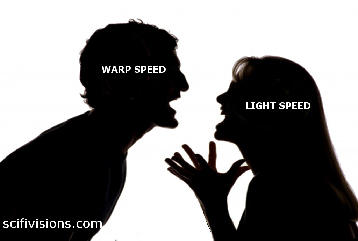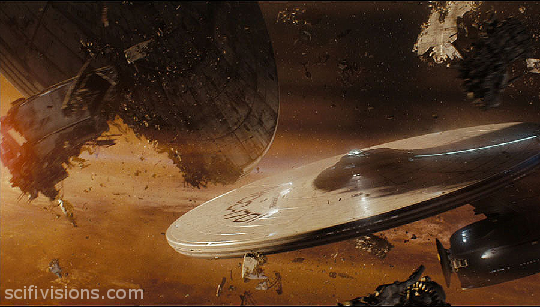Post by sfv on May 8, 2018 18:52:38 GMT
Part One: Time vs. Distance in Space Travel

First let’s just pick up the debate about which is faster; warp speed or light speed (hyperspace) and dump it in the trash shall we? You can’t in any rational (if arguing about science fiction is rational) way compare the two because they involve different principles. Warp speed is just that, warping space and time to allow a ship to exceed the speed of light in our reality, bypassing physics as we know it. Light Speed (hyperspace) is an alternate reality or dimension that allows a ship to travel faster than the speed of light by simply ignoring the physical constraints of our reality.
Good? Can we move past the fan boy bickering? No? Oh well, I tried.

Anyway, let’s jump to what seems to be plaguing some modern story telling on the big screen and for that I have to pick on J.J. Abrams first and in picking on him I’ll jump straight to Star Trek. I would go after Star Wars but he didn’t offend on this topic with the Force Awakens as much as he did with Star Trek.

Love it or hate it you have to admit that J.J. has brought a fresh take to what had grown kind of stale over the years. I can’t fault the time travel aspect as it had been done many times before and shaking up what we already know even if it is in just this one reality, the accelerated growth of classic characters has been nothing if not fun.
Where J.J. succeeds in his fresh take on the Star Trek universe though he fails horribly in the speed in which his ships travel between points for the sake of storytelling. I will start my argument off with the fleet of fresh cadets on sparkling new ships leaving port to travel to Vulcan. As they pull away from their moorings, line up in formation and jump to warp speed we see the Enterprise hilariously left behind because her helmsman left the proverbial parking brake on. A quick fix (popping the clutch) and bang we are at warp speed on our way to the rescue.
Now this is where we could have had some character growth as the ship speeds its way to the rescue of the Vulcan people. Star Trek 2: The Wrath of Khan did this so well. How about some playful interaction as characters tour the ship? Maybe some reflection since we have been pushing so hard and fast to raise Kirk up from farm boy who lost his father to the Star Fleet officer we all know and love? Nope, we get a quick discovery that something is wrong in the transmission that really didn’t help the plot anyway because the ship still drops out of warp into a mangled mass of what was once that gleaming new fleet filled with fresh faced kids.

An argument could be made that because the timeline is different and technology could have advanced far quicker that it did previously because of the arrival of the advanced Romulan ship years earlier, but I direct you to later in the movie (well not really that much later) when Kirk is stranded. We spend far more time here learning that there is an older Spock from the future, meeting Scotty and preparing to transport across vast stretches of space than we ever did on the original trip between Earth and Vulcan.
Now please don’t get me wrong. I love this movie but this to me is a sticking point because it is lazy. It really doesn’t take much to show a passage of time as you are hurtling across the galaxy from one point to another. The before mentioned Wrath of Khan did it. Star Wars: A New Hope did it with a somewhat short but poignant lightsaber training scene on the Millenium Falcon. It could easily be assumed that the training lasted a bit, allowing for the time it took to traverse between Tatooine in the Outer Rim and the spot in space formally known as Alderaan . The Empire Strikes Back played up the time it took the Falcon to reach Bespin by intermixing Luke’s training on Dagobah. Heck even the Ice Pirates did it by simply saying it was going to take X number of days to get to their destination. Simple but it works.
I’m going to skip the other J.J. lapse into lazy writing…er I mean overly convenient plot point (transporting from Earth all the way to Kronos? Seriously?) and take a shot at the Last Jedi and the troubled side story of Canto Bight. Setting aside missed opportunities here (cough Lando cough) here again we see the setting aside of time/distance for the sake of a rushed story point. You have to figure the time Finn and Rose blew just on the planet between walking to the casino, looking for their target, getting caught and thrown in jail, their escape and flight thru the city and finally their rescue off the planet had eaten up a majority of the finite time they had away from their crumbling fleet. Given that, the trip to Canto Bight and back had to have only taken a half hour to an hour tops each way. On a recent map of the Star Wars galaxy the path of the resistance fleet and Cantonica are nearly a third the way across the galaxy from each other and that is hauling some major rear end even for the Falcon and they were in a dinky little shuttle/transport. This kind of space travel ruins any suspense in story telling as fleets can hit any point in the galaxy in under a day.

I could go on but I wanted to stress two glaring issues in recent movies (yes I know Star Trek isn’t THAT recent). My point to this is if you are a writer use the vast distances of space to your advantage. Have the mentor spend time training his student or passing along sage advice. Explore the ship you are on and possibly set up story points to exploit later on. Or just say “well it’s gonna take three days to get to the pleasure planet so I’m gonna hit Netflix for a bit then have a nice nap”.
Or you could cut away to a side story somewhere else. Yeah that could work too.
- J Spix


